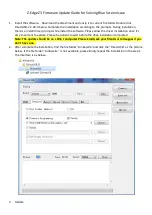
I. OVERVIEW
5
Canon’s patents are a measure of intellectual wealth and corporate ethos. Discoveries in
the core technologies are applied to products for industry, healthcare, broadcasting,
business and consumers. Because Canon continues to innovate at a furious pace, each new
product incorporates significant advances in electronics, mechanics, optics and software.
Any new product from Canon, but especially a new digital single lens reflex camera, is
the fruit of this intellectual wealth. For instance, virtually every significant piece of
hardware in the new EOS Digital Rebel XT is designed and made by Canon on machinery
that is also designed, made and maintained by Canon.
As early as the mid-1980s, Canon made the risky and challenging decision that it would,
eventually, design and manufacture its own image sensor chips for digital SLRs rather
than purchase off-the-shelf image sensors from an external supplier. Canon’s
extraordinary success in this venture has freed it from the syndrome of me-too products
with the same internals as everyone else’s. Similar achievements were made in the
design, development and manufacturing of Canon EF lenses and DIGIC
®
image
processors, which together with Canon CMOS image sensors comprise the three main
components of every Canon EOS digital camera. As it pushes the limits of technology,
Canon can optimize the design, performance and cost of every key component in every
new digital single lens reflex camera it makes.
Canon EOS DSLRs are unique in the photography industry in terms of their design and
manufacturing and, therefore, their performance and value. This is the heritage of the
EOS Digital Rebel XT camera.
EOS Digital Rebel XT Advantages
The EOS Digital Rebel XT camera has 8 million effective pixels on its sensor. Several
competitive models have about 6 million pixels. How much do those extra pixels
matter? Also, there are compact consumer or “prosumer” cameras that cost between
$700 and $1000 and also have 8 million pixels. How do they compare?
It is generally understood that if one has more pixels, one can make bigger prints.
Having more pixels also means that one can crop a bit from one’s original image and
still have lots of pixels left for printing. Pixel quantity also matters because several
components of image quality are resolution dependent. Aliasing, or “jaggies,” gives a
rough-edged appearance to lines that cut diagonally across the rectilinear grid of square
pixels. More pixels reduce the effects of aliasing and improve image quality. Based on
these factors, the EOS Digital Rebel XT has a clear advantage compared to any digital
SLR with lower resolution.
8-megapixel compact digital cameras use image sensors that are much smaller than the
unit in the EOS Digital Rebel XT camera. Most are 8.8 mm by 6.6 mm, compared to the
22.2 mm by 14.8 mm sensor in the XT. Each pixel is therefore much, much smaller in






































